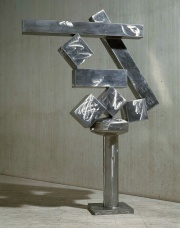Stainless steel
Description
Any of several Iron alloys (i.e., steels) made corrosion-resistant by the addition of Chromium. Austenitic stainless steels, developed by E. Maurer of Germany in 1909, contain about 12-18% Chromium and 5-8% Nickel. These alloys harden by cold working and are most often used for structural work. In 1911, C. Dantsizen of Germany developed ferritic stainless steel. This low carbon chrome alloy was used for turbine blades. It contains about 10.5-27% chromium with small amounts of Molybdenum, Aluminum, Titanium, or Nickel. In 1913, martensitic stainless steels were discovered by H. Brearley of England. Containing 11-18% chromium with about 0.35% Carbon, they are used for cutlery and munitions. Stainless steel can be polished to a high shine either mechanically or by an electrolytic process. It is hardened by cold working and is resistant to heat. From 1930s to 50s, stainless steel was popularly used for exterior and interior construction and decoration (dome of the Chrysler building, countertops, soda fountains, automobiles, stoves). Later, it was commonly used for framing, hardware, roofing, gutters, screws and nails. Various stainless steels may contain small amounts or other additives such as nickel, Columbium, molybdenum, Phosphorus, Selenium, Silicon, Sulfur, titanium, and Zirconium.
Synonyms and Related Terms
inox; Allegheny metal; Ascoloy; Enduro; Nirostametal; Rigid-Tex; chromium steel; rustfrit stål (Dan.); Edelstahl (Deut.); acero inoxidable (Esp.); acier inoxydable (Fr.); acciaio inox (It.); roestvast staal (Ned.); stal nierdzewna (Pol.); aço inoxidável (Port.); aço inox (Port.); rostfritt stål (Sven.)
Other Properties
Attacked by hydrochloric acid.
Forms a transparent protective layer of chromium oxide in air.
Hazards and Safety
Welding can cause the depletion of chromium in heated areas (blue halo) leaving them susceptible to corrosion. Galvanic corrosion can occur in contact with lead, nickel, copper and graphite.
Additional Information
R. Score, I. Cohen, "Stainless Steel", in Twentieth-Century Building Materials, T. Jester (ed.), McGraw-Hill: New York, 1995.
Sources Checked for Data in Record
- Dictionary of Building Preservation, Ward Bucher, ed., John Wiley & Sons, Inc., New York City, 1996
- Thomas C. Jester (ed.), Twentieth-Century Building Materials, McGraw-Hill Companies, Washington DC, 1995
- G.S.Brady, Materials Handbook, McGraw-Hill Book Co., New York, 1971 Comment: p.670
- Richard S. Lewis, Hawley's Condensed Chemical Dictionary, Van Nostrand Reinhold, New York, 10th ed., 1993
- Van Nostrand's Scientific Encyclopedia, Douglas M. Considine (ed.), Van Nostrand Reinhold, New York, 1976
- Random House, Webster's Encyclopedic Unabridged Dictionary of the English Language, Grammercy Book, New York, 1997
- The American Heritage Dictionary or Encarta, via Microsoft Bookshelf 98, Microsoft Corp., 1998
- Wikipedia, the free encyclopedia, at http://www.wikipedia.com Comment: http://en.wikipedia.org/wiki/Stainless_steel (Accessed Mar. 1, 2006)
- Michael McCann, Artist Beware, Watson-Guptill Publications, New York City, 1979
- Website address 1 Comment: Stainless steel at www.answers.com

